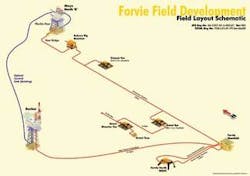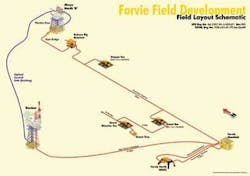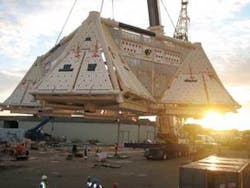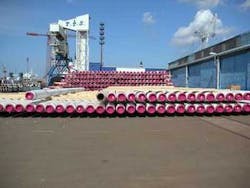North Sea Forvie field overcomes technical challenges of long-distance pipe-in-pipe
Fasttrack project scores success with ambitious design
Stephane Janton, Total E&P UK
Total’s recently onstream Forvie North gas condensate field is located in block 3/15 of the UK Northern North Sea, and has been developed with a single production subsea tree. The well is tied back to the new subsea Forvie manifold 2.3 km away, which in turn is tied back to the North Alwyn B platform with a 15-in. x 32-km subsea pipeline. The control umbilical is routed 17.4 km to the Dunbar platform.
Topside integration on these installations, also operated by Total, was another feature of the project. The development provides for future tie-ins of adjacent prospects, such as Forvie Central and Jura West.
After a conceptual phase, Total kicked off front-end engineering design studies for Forvie North in April 2004, and first gas was achieved in December 2005. This represents one of the fastest schedules for a project of this nature, combined with an ambitious design.
Key features were:
- subsea facilities rated to 520 bars (WHSP) and 95°C for the late field life
- pipeline designed for 20-hr cool-down times (pipe-in-pipe system required)
- manifold overall weight of 278 tons
- wellhead protection structure of 128 tons
- 9-in. flexible riser fully rated.
What were the main parameters in this project? The following four points were particularly important:
- Total’s internal technical expertise allowed us to rapidly select and freeze a suitable design and to have direct discussions with our suppliers. The project schedule would not have been possible without this in-house capability. Also, Forvie North has incorporated experience from the company’s previous North Sea projects and elsewhere, including several deep-sea type designs
- We knew that the oil industry was experiencing constraints such as steel delivery, contractor resources, and lay barge availability. This impression was reinforced at an early stage in the project through a market survey and feedback from one potential contractor
- A “comfortable” standard engineering, procurement, installation, and construction contract approach was not compatible with our first gas objectives. We decided therefore to manage directly the numerous contractor and suppliers involved in the project. Around seven main suppliers and seven contractors were involved in the development, under the direction of the Total project team
- This strategy, which had been detailed in our project execution plan, was quickly approved. Our team was confident in its management capabilities. There is an ongoing debate on the pros and cons of full EPIC and multiple contracts. But perhaps the real question should be: “Do I have the flexibility to do what is best to suit my objective?”
A project can be dramatically affected if there is not strict control of design changes: it is human nature to aim to optimize. But this was not compatible with our schedule-driven project. We therefore insisted on strong discipline to limit and control possible changes to the design. Also, we ensured a fast decision-making process was in place, allowing early commitment when required.
Technical challenges
In some domains, Forvie North not only uses the best technology available, but pushes the technical envelope a bit further. Three examples are given below.
Pipe-in-pipe system:To develop this project, one of the key requirements was to maintain the gas warm enough along the 32 km from the well to the platform to avoid hydrate formation. We requested a challenging requirement of 20-hr cool-down before reaching the low temperature limit. This cool-down duration has increased the operational flexibility, limiting the need for pipeline depressurization in case of a shutdown.
The selected pipe-in-pipe system from ITP InTerPipe fulfilled and exceeded the thermal requirement. (The measured U-value reached 0.8 W/m2*K based on the inner pipe inner diameter, including field joints; this means a U-value of 0.65 W/m2*K based on the outer diameter). This thermal performance is currently the best achieved in the North Sea.
High pressure flexible riser: A key design issue was the riser selection on the modified Alwyn platform. The solution was a 9-in. ID flexible riser fully rated to 520 bars, pulled into an existing caisson. This diameter/pressure combination represents a first by the supplier NKT for a gas flexible. The design has also simplified considerably the construction work compared with a retrofitted steel riser.
Subsea control system: The subsea controls supplier (Dril-Quip) provided a robust system. One stand-out innovation is that the communication of this control system is based on an industry standard protocol, Modbus.
This is a first, as other subsea control systems are based on proprietary communication protocols. Standardization gave a straightforward interface between the topside and subsea control system and allowed an easy start-up. It was also the first Dril-Quip system of this type ever installed.
Despite the fasttrack nature of the project, our team maintained a strong safety performance throughout the duration of this project.
In conclusion, this type of development shows Total’s willingness to put its discoveries onstream quickly. Consequent provisions have been allowed to tie-in other possible prospects in the vicinity, so hopefully, the story of Forvie is not yet closed.
Fasttrack demands on pipe-in-pipe system
For Forvie’s export pipeline, Total selected ITP InTerPipe’s pipe-in-pipe system: this is claimed to provide high thermal performance, due largely to the use of ITP’s proprietary microporous, Izoflex insulation.
The choice of pipe-in-pipe for this project was critical not just in terms of flow assurance, but also due to offshore installation issues. With demand for pipelay vessels at near-record levels, laying spreads can be difficult to secure for fasttrack projects. This meant that Forvie’s pipe-in-pipe had to be installable by each North Sea offshore contractor. Moreover, the field jointing process had to be as rapid as possible in order to shorten the required pipelay window (thereby increasing the potential vessel availability).
Total’s project team selected ITP InTerPipe’s proprietary field joint system, which offered the advantage of requiring only one weld to be performed per joint. With this system, only the inner pipe, carrying the wellstream, needs to be welded offshore: this is due to a highly insulated steel sleeve slid over the field joint area, which ensures thermal and mechanical continuity of the system at the joint.
This in turn allows more working stations to be dedicated to welding of the inner pipe and to non-destructive testing onboard the pipelay vessel, leading to a much faster lay rate for pipe-in-pipe compared with other field jointing methods, the company claims. The field joint system had previously been deployed on several deepwater West African projects, but Forvie was the first application in the North Sea.
For the detailed design of the pipe-in-pipe, Total collaborated with ITP and JP Kenny as an integrated team. While JPK managed the overall pipeline design, ITP performed the detailed thermal and mechanical design of the pipe-in-pipe, especially the field joints. This work was cross-checked by JPK using its in-house methodology.
In parallel, Total imposed third-party verification by an international certification agency on all the contractors involved. These independent checks covered both the design and fabrication of the pipe-in-pipe double joints, held in a dedicated yard in northern France, providing rail access and a deep-draft dock for cargo barges.
With fasttrack projects, logistics can also be critical, although that was not the case here; the pipes were delivered from France (V&M tubes) and Germany (Mannesmann linepipe) directly to the fabrication site where they were assembled into pipe-in-pipe double joints and loaded on cargo barges bound for the Shetland Isles. A scheme with a minimum handling of pipes was set up for schedule as well as safety reasons. Each pipe-in-pipe double joint weighed about 11 tons.
Allseas’Solitaire was contracted for the pipelay. Although the pipe to be welded offshore was very thick, Allseas achieved a high lay rate. Installation was completed in August 2005.



